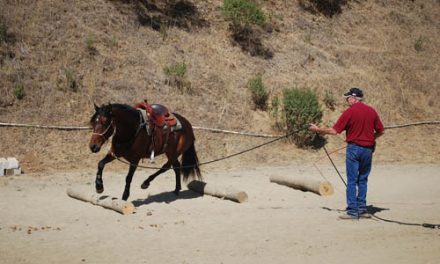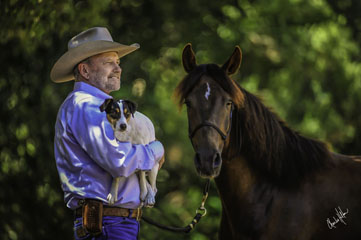Notes From Julie

Julie and Dually
A few days ago, I drove through South Park, Colorado (yes, there really is such a place and it is well depicted in the cartoon), looking out over hundreds of thousands of acres of pasture land with thousands of cattle, horses, elk and antelope ranging, I was gazing at the incredible scenery, basking in the high-mountain splendor.
My day-dreams were rudely interrupted by a scene that irritates me every time I see it: horses turned out with halters on. Unfortunately, we see that a lot around here; sometimes the horses are turned out in rope halters, which is even worse since they will not break. I am not sure whether this is done out of ignorance, laziness or simple incompetence, but I am sure it is not a good idea.
In my opinion, there’s no good reason to turn a horse loose in a halter and leaving a halter on 24/7 is very poor horsemanship. It is uncomfortable, potentially dangerous to the animal and it will not resolve any training issues that the horse might have. Turned loose in a halter, the horse may potentially snag the halter on something and be stuck. Maybe he’ll panic and break free, maybe he’ll throw himself on the ground and struggle; either way the potential for hurting himself is huge.
Besides, how would you like to have that thing on your head all the time? Maybe some people think because we leave collars on dogs, it is ok to leave halters on horses, but a dog does not have the same capacity for panic and destruction that horses have.
Often I hear people say they leave a halter on because their horse is difficult to catch. But guess what? That’s not fixing the problem—it’s avoiding it. Training and good handling will fix a hard-to-catch horse (Find out more in the sidebar); leaving a halter on 24/7 will not. I’ve worked with many wild, unhandled or traumatized horses and the temptation to leave a halter on is great. But until the horse is desensitized to your approach, your touch and the halter going on and off, your problem is not solved.
I can imagine that in some circumstances leaving the halter on might be a reasonable temporary solution, but at some point the horse has got to be trained. Leaving the halter on 24/7 does not train the horse to accept these things—only physically doing it will. Have you worked with a horse you had to leave the halter on? Why? Was it temporary or permanent?
There are some horses in my neighborhood that have their halters on 24/7 and it makes me cringe every time I drive by. I am not sure who owns them or why they leave halters on some horses and not others, but I’ve never seen anyone handling these horses or doing anything with them. My guess is that it is done from sheer ignorance.
I’ve known a lot of horse breeders through the years who like to halter break their youngsters by leaving a halter on and dragging a lead rope for weeks on end. I’ve even known people that will tie the lead rope to a big tire and even to a donkey. This has always bothered me because I think it is very uncomfortable and confusing for the young horse.
There are a lot of training techniques out there that I would never use but I respect the rights of others to use them as long as they do not hurt the horse and if they have good results. But for me, it has to make sense to the horse and respect his right to be comfortable on his own time. What training techniques have you seen or heard of that don’t make sense to you? I’d love to hear about them.
Enjoy the ride,
Julie
Find more free articles to read and refer to in Julie’s Training Library: http://juliegoodnight.com/q&a.php and watch Horse Master on RFD-TV every Monday at 12:30 and 10:30p EST —Direct TV channel 345, Dish Network channel 231 and on many cable outlets. Then visit http://www.horsemaster.tv and http://www.juliegoodnight.com/clinics for the clinic schedule, articles related to each episode, the gear used in each show, and for training DVDs and publications. Plus, see clips from each show at: http://www.horsemaster.juliegoodnight.com and check out specials and even more clips on Goodnight’s Facebook Fan Page: http://www.facebook.com/horsemaster.tv. Sign up for his free monthly newsletter at: http://juliegoodnight.com/emailsignup.php. Goodnight is proud to recommend Myler Bits, Nutramax Laboratories, Circle Y Saddles, Redmond Equine, Bucas Blankets and Spalding Fly Predators. Goodnight is the spokesperson for the Certified Horsemanship Association.
SIDEBAR:
To Catch a Horse
For your hard-to-catch horse: you need to “walk him off.” To do that, put on a pair of comfortable walking shoes and allow yourself plenty of time (you shouldn’t need more than an hour). Walk out into that pasture/pen with halter in hand (don’t try to hide it) and look your horse square in the eyes with a look on your face that says, “I am going to catch you, even if it takes me ALL day!”
Walk after your horse, straight towards his head, looking him straight in the eye. Do not chase him and do not try to corner him or any of those other games horses love to play.
He will run off, tail up in the air, but the mental pressure you are putting on him will start to drive him crazy. It may take a while (the worst horse I ever walked-off took 45 minutes) but eventually he will not be able to take the pressure and he will stop, turn and face you with his head down. At this point you should stop and turn your back to him for a moment, taking the pressure off of him as a reward for doing the correct thing.
Then approach him slowly and casually with your eyes down and averted and your shoulders cocked away from the horse (there must be a distinct difference in your body language from when you are pursuing him to when you are walking up to him after he has given in). Put the halter on, lead him a few steps, pet on him and let him go. You could give him a treat at this point if you want to (only AFTER you have caught him, NEVER use a treat as a bribe to catch a horse).
The next day, you’ll head out to catch your horse in the exact manner but you’ll find it will only take a few minutes, from then on he should be fine. Horses are very keen to your level of intention and determination. This process proves to your horse that you have very serious intentions to catch him and he will not challenge you anymore.





